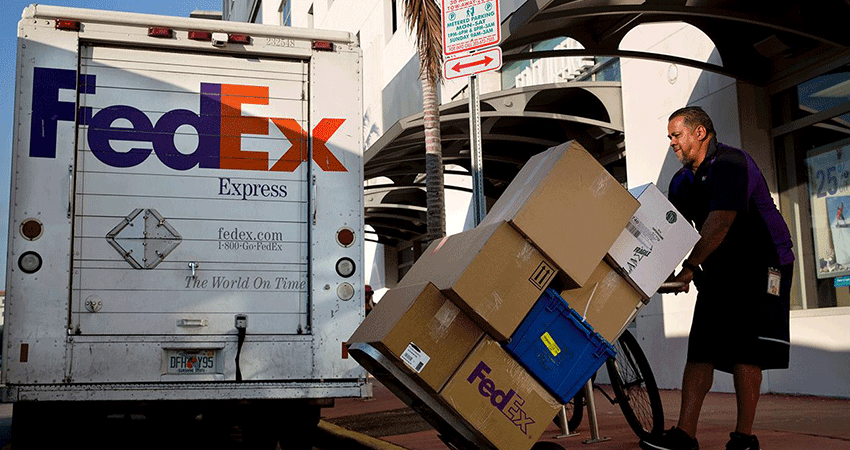Starting in January, FedEx will make deliveries seven days a week to meet increasing demand from ecommerce shippers, while diverting about 2 million packages per year from the U.S. Postal Service’s last-mile service to build necessary density and shave costs.
UPS began expanding its six-day delivery in 2017 and FedEx did so this year. Both carriers have been doing seven-day delivery during peak season in November and December. The seven-day deliveries from FedEx will cover most addresses in the U.S.
UPS CEO David Abney went on Bloomberg TV after the FedEx news broke, saying his company is “starting to hear more” about the need for Sunday delivery, stopping short of saying it will be implemented soon.
“We’re looking at it right now,” Abney said. “In our last contract that just recently got ratified (last fall with the Teamsters union representing drivers and package handlers), we have language that covers us for Saturday and Sunday (delivery), so we are pretty far down the path. We will talk about it, and we have more to review.”
UPS’s 2018 contract with the Teamsters created a new category of lower-tier “hybrid drivers” to handle weekend deliveries, which the union vehemently opposed but ultimately accepted.
Abney also sought to differentiate UPS from its main competitor, saying it provides Saturday pickups at businesses in over 170 countries for Monday delivery, where FedEx doesn’t. “That’s been our key,” he said.
FedEx said it is making changes to enhance its last-mile efficiency as it expands its coverage. The 2 million packages being diverted from its SmartPost service handled by USPS will now be delivered by FedEx Ground’s residential drivers. FedEx did not say what the financial impact of seven-day delivery will be, but it’s sure to be costly in terms of labor, fuel and facilities.
“Delivery density has consistently been a challenge with ecommerce,” said FedEx Ground President Raj Subramaniam in a release. “We anticipate substantial density improvement and efficiency opportunities when all residential packages are sorted and delivered within the same ground network.”
Since 2016, FedEx has been using technology to save costs by diverting parcels from the USPS to its ground network if other packages were bound for nearby addresses; that figure is now about 20% of SmartPost volume. The company anticipates the “vast majority” of SmartPost packages will be integrated into ground by the end of 2020.
“Like any prudent business, we do not publicly discuss specifics of our business relationships,” said USPS spokesman David Partenheimer when asked about FedEx’s move.
Subramaniam said FedEx’s investments in capacity, technology and automation have allowed it to gain ground market share and position the company to handle daily small parcel volume that it expects to double by 2026. “Expanding our operations to include Sunday residential deliveries further increases our ability to meet the demands of ecommerce shippers and online shoppers,” he said.
At the same time, FedEx said it is making changes to handle the increasing volume of heavier, bulkier items, which make up about 10% of its ground volume as more consumers get comfortable ordering them online. This includes designing new facilities, adding equipment to existing facilities and other operational adjustments.
Paul Steiner, vice president of strategic analysis for supply chain consultancy Spend Management Experts, said FedEx’s expansion to seven-day delivery is “a game-changer” that addresses the need for ecommerce speed and convenience for customers.
“The big question is, how and when will UPS respond?” Steiner said. “As for moving more SmartPost packages via (FedEx’s) own network, it’s a smart move and one that UPS has been doing with its SurePost packages for a while now. However, the result will be lost volume for USPS which is already losing business from Amazon as it builds out its own delivery network.”
Paul Huppertz, a director at supply chain consultancy Crimson & Co., sounded a similar note, saying he believed part of FedEx’s rationale for going to all-week delivery was to address the growing threat of Amazon’s delivery services. Amazon in its 2018 10K report named the major carriers as competitors for the first time.
“Bringing SmartPost volume back from the USPS says more about the increase in residential package delivery volume,” Huppertz continued. “FedEx can opportunistically divert SmartPost deliveries back onto its trucks, improving route density and leaving the low-density stops for USPS.”
Jerry Hempstead, principal at parcel spend firm Hempstead Consultants, said he believes UPS “will be forced into” seven-day delivery from market pressure after FedEx’s move.
“They’ve already developed technology to divert packages away from the USPS,” Hempstead said. “Yesterday’s FedEx announcement shows they’ve figured it out as well. None of this is good for the USPS.”
He added the USPS’s new Parcel Select dimensional pricing rule, reducing its DIM divisor from 194 to 166 for packages over 1 cubic foot as of June 23, is going to cost the parcel carrier even more parcel volume. FedEx and UPS changed their DIM divisors on most express and ground services from 166 to 139 a couple years ago.
“The technology will do its thing and divert more SurePost, SmartPost and Amazon packages onto their own trucks,” Hempstead said. “I think the USPS made a mistake with its pricing.”

